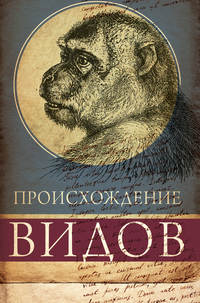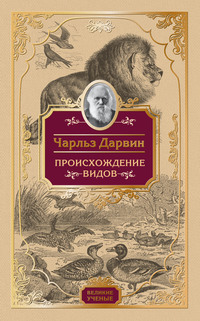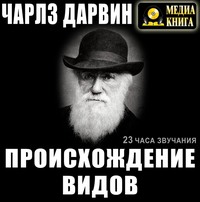
The Foundations of the Origin of Species
421
Origin, Ed. i. p. 291, vi. p. 426.
422
Origin, Ed. i. p. 288, vi. p. 422.
423
Origin, Ed. i. p. 289, vi. p. 423.
424
Origin, Ed. i. p. 300, vi. p. 439.
425
Ch. XIII of the Origin, Ed. i., Ch. XIV Ed. vi. begins with a similar statement. In the present Essay the author adds a note: – “The obviousness of the fact (i. e. the natural grouping of organisms) alone prevents it being remarkable. It is scarcely explicable by creationist: groups of aquatic, of vegetable feeders and carnivorous, &c., might resemble each other; but why as it is. So with plants, – analogical resemblance thus accounted for. Must not here enter into details.” This argument is incorporated with the text in the Origin, Ed. i.
426
Origin, Ed. i. p. 411, vi. p. 566.
427
Origin, Ed. i. p. 316, vi. p. 457.
428
Origin, Ed. i. p. 321, vi. p. 463.
429
In the Origin, Ed. i. this preliminary matter is replaced (pp. 411, 412, vi. pp. 566, 567) by a discussion in which extinction is also treated, but chiefly from the point of view of the theory of divergence.
430
Origin, Ed. i. p. 414, vi. p. 570.
431
Origin, Ed. i. p. 414, vi. p. 570.
432
These instances occur with others in the Origin, Ed. i. p. 416, vi. p. 572.
433
Origin, Ed. i. p. 418, vi. p. 574.
434
Origin, Ed. i. pp. 419, 440, vi. pp. 575, 606.
435
Origin, Ed. i. pp. 418, 425, vi. pp. 574, 581.
436
Origin, Ed. i. p. 413, vi. p. 569.
437
Origin, Ed. i. pp. 419, 427, vi. pp. 575, 582.
438
This is discussed from the point of view of divergence in the Origin, Ed. i. pp. 420, 421, vi. pp. 576, 577.
439
«Footnote by the author.» I discuss this because if Quinarism true, I false. «The Quinary System is set forth in W. S. Macleay’s Horæ Entomologicæ, 1821.»
440
In the corresponding passage in the Origin, Ed. i. p. 430, vi. p. 591, the term general is used in place of generic, and seems a better expression. In the margin the author gives Waterhouse as his authority.
441
Origin, Ed. i. p. 430, vi. p. 591.
442
In a corresponding passage in the Origin, Ed. i. p. 423, vi. p. 579, the author makes use of his knowledge of pigeons. The pseudo-genera among dogs are discussed in Var. under Dom., Ed. ii. vol. I. p. 38.
443
Origin, Ed. i. pp. 419, 427, vi. pp. 575, 582.
444
Origin, Ed. i. pp. 423, 427, vi. pp. 579, 583.
445
Origin, Ed. i. p. 423, vi. p. 579.
446
A general statement of the influence of conditions on variation occurs in the Origin, Ed. i. pp. 131-3, vi. pp. 164-5.
447
Origin, Ed. i. p. 423, vi. p. 579. In the margin Marshall is given as the authority.
448
Origin, Ed. i. p. 423, vi. p. 579.
449
The discussion here following corresponds more or less to the Origin, Ed. i. pp. 411, 412, vi. pp. 566, 567; although the doctrine of divergence is not mentioned in this Essay (as it is in the Origin) yet the present section seems to me a distinct approximation to it.
450
The author probably intended to write “groups separated by chasms.”
451
A similar discussion occurs in the Origin, Ed. i. p. 427, vi. p. 582.
452
Puffinuria berardi, see Origin, Ed. i. p. 184, vi. p. 221.
453
Origin, Ed. i. p. 430, vi. p. 591.
454
Origin, Ed. i. p. 434, vi. p. 595. Ch. VIII corresponds to a section of Ch. XIII in the Origin, Ed. i.
455
Origin, Ed. i. p. 434, vi. p. 596. In the Origin, Ed. i. these examples occur under the heading Morphology; the author does not there draw much distinction between this heading and that of Unity of Type.
456
See Origin, Ed. i. p. 436, vi. p. 599, where the parts of the flower, the jaws and palpi of Crustaceans and the vertebrate skull are given as examples.
457
The author here brings Unity of Type and Morphology together.
458
The solid-hoofed pigs mentioned in Var. under Dom., Ed. ii. vol. II. p. 424 are not Lincolnshire pigs. For other cases see Bateson, Materials for the Study of Variation, 1894, pp. 387-90.
459
In the margin C. Bell is given as authority, apparently for the statement about Plesiosaurus. See Origin, Ed. i. p. 436, vi. p. 598, where the author speaks of the “general pattern” being obscured in “extinct gigantic sea lizards.” In the same place the suctorial Entomostraca are added as examples of the difficulty of recognising the type.
460
Origin, Ed. i. p. 438, vi. p. 602.
461
Origin, Ed. i. p. 439, vi. p. 604.
462
The uselessness of the branchial arches in mammalia is insisted on in the Origin, Ed. i. p. 440, vi. p. 606. Also the uselessness of the spots on the young blackbird and the stripes of the lion-whelp, cases which do not occur in the present Essay.
463
In the Origin, Ed. i. pp. 442, 448, vi. pp. 608, 614 it is pointed out that in some cases the young form resembles the adult, e. g. in spiders; again, that in the Aphis there is no “worm-like stage” of development.
464
In the Origin, Ed. i. p. 449, vi. p. 618, the author speaks doubtfully about the recapitulation theory.
465
This corresponds to the Origin, Ed. i. p. 441, vi. p. 607, where, however, the example is taken from the Cirripedes.
466
Origin, Ed. i. p. 449, vi. p. 617.
467
This corresponds to the Origin, Ed. i. pp. 443-4, vi. p. 610: the “feline animal” is not used to illustrate the generalisation, but is so used in the Essay of 1842, p. 42.
468
Origin, Ed. i. p. 447, vi. p. 613.
469
In the margin is written “Get young pigeons”; this was afterwards done, and the results are given in the Origin, Ed. i. p. 445, vi. p. 612.
470
In the Origin, Ed. i. the corresponding passages are at pp. 8, 13, 443, vi. pp. 8, 15, 610. In the Origin, Ed. i. I have not found a passage so striking as that which occurs a few lines lower “that the germinal vesicle is impressed with some power which is wonderfully preserved, &c.” In the Origin this preservation is rather taken for granted.
471
«In the margin is written» Aborted organs show, perhaps, something about period «at» which changes supervene in embryo.
472
See p. 42, note 5.
473
The evidence is given in Var. under Dom., I. p. 316.
474
Origin, Ed. i. p. 444, vi. p. 610.
475
In Var. under Dom., Ed. ii. vol. I. p. 295, such eggs are said to be laid early in each season by the black Labrador duck. In the next sentence in the text the author does not distinguish the characters of the vegetable capsule from those of the ovum.
476
This seems to me to be more strongly stated here than in the Origin, Ed. i.
477
Origin, Ed. i. p. 444, vi. p. 611.
478
Origin, Ed. i. p. 441, vi. p. 607.
479
Compare Origin, Ed. i. p. 419, vi. p. 575.
480
«Note in original.» Scarcely possible to distinguish between non-development and retrograde development.
481
See p. 42, where the same illustration is used.
482
Var. under Dom., Ed. ii. vol. I. p. 452.
483
Origin, Ed. i. p. 441, vi. p. 607.
484
Origin, Ed. i. p. 449, vi. p. 617.
485
Origin, Ed. i. p. 449, vi. p. 618.
486
In the Origin, Ed. i. p. 450, vi. p. 619, the author does not lay stress on any distinction in meaning between the terms abortive and rudimentary organs.
487
Origin, Ed. i. p. 450, vi. p. 619.
488
Ibid.
489
This argument occurs in Origin, Ed. i. p. 451, vi. p. 619.
490
Origin, Ed. i. p. 451, vi. p. 619, on male mammæ. In the Origin he speaks certainly of the abortive mammæ of the cow giving milk, – a point which is here queried.
491
Origin, Ed. i. p. 451, vi. p. 620.
492
The case of rudimentary organs adapted to new purposes is discussed in the Origin, Ed. i. p. 451, vi. p. 620.
493
This is here stated on the authority of Sprengel; see also Origin, Ed. i. p. 452, vi. p. 621.
494
Origin, Ed. i. p. 455, vi. p. 627. In the margin R. Brown's name is given apparently as the authority for the fact.
495
Origin, Ed. i. p. 455, vi. p. 626.
496
Origin, Ed. i. p. 454, vi. p. 625.
497
In the Origin, Ed. i. p. 454, vi. p. 625, the author in referring to semi-monstrous variations adds “But I doubt whether any of these cases throw light on the origin of rudimentary organs in a state of nature.” In 1844 he was clearly more inclined to an opposite opinion.
498
Origin, Ed. i. p. 454, vi. p. 625.
499
See Origin, Ed. i. p. 454, vi. p. 625. The author there discusses monstrosities in relation to rudimentary organs, and comes to the conclusion that disuse is of more importance, giving as a reason his doubt “whether species under nature ever undergo abrupt changes.” It seems to me that in the Origin he gives more weight to the “Lamarckian factor” than he did in 1844. Huxley took the opposite view, see the Introduction.
500
Origin, Ed. i. p. 455, vi. p. 627.
501
Origin, Ed. i. p. 11, vi. p. 13, where drooping-ears of domestic animals are also given.
502
Origin, Ed. i. p. 137, vi. p. 170.
503
These words seem to have been inserted as an afterthought.
504
Origin, Ed. i. p. 444, vi. p. 611.
505
This and similar cases occur in the Origin, Ed. i. p. 452, vi. p. 621.
506
The metaphor of the dishes is given in the Essay of 1842, p. 47, note 3.
507
Compare however Darwin’s later view: – “The possibility of making distinct races by crossing has been greatly exaggerated,” Origin, Ed. i. p. 20, vi. p. 23. The author’s change of opinion was no doubt partly due to his experience in breeding pigeons.
508
In the Origin, Ed. i. p. 469, vi. p. 644, Darwin makes a strong statement to this effect.
509
“A grain in the balance will determine which individual shall live and which shall die,” Origin, Ed. i. p. 467, vi. p. 642. A similar statement occurs in the 1842 Essay, p. 8, note 3.
510
Thus according to the author what is now known as orthogenesis is due to selection.
511
Part II begins with Ch. IV. See the Introduction, where the absence of division into two parts (in the Origin) is discussed.
512
In the recapitulation in the last chapter of the Origin, Ed. i. p. 475, vi. p. 651, the author does not insist on this point as the weightiest difficulty, though he does so in Ed. i. p. 299. It is possible that he had come to think less of the difficulty in question: this was certainly the case when he wrote the 6th edition, see p. 438.
513
«The following words:» The fauna changes singly «were inserted by the author, apparently to replace a doubtful erasure».
514
This question forms the subject of what is practically a section of the final chapter of the Origin (Ed. i. p. 480, vi. p. 657).
515
Origin, Ed. i. p. 481, vi. p. 659.
516
The discussion on the three species of Rhinoceros which also occurs in the Essay of 1842, p. 48, was omitted in Ch. XIV of the Origin, Ed. i.
517
This corresponds to a paragraph in the Origin, Ed. i. p. 483, vi. p. 662, where it is assumed that animals have descended “from at most only four or five progenitors, and plants from an equal or lesser number.” In the Origin, however, the author goes on, Ed. i. p. 484, vi. p. 663: “Analogy would lead me one step further, namely, to the belief that all animals and plants have descended from some one prototype.”
518
This sentence corresponds, not to the final section of the Origin, Ed. i. p. 484, vi. p. 664, but rather to the opening words of the section already referred to (Origin, Ed. i. p. 480, vi. p. 657).
519
This simile occurs in the Essay of 1842, p. 50, and in the Origin, Ed. i. p. 485, vi. p. 665, i. e. in the final section of Ch. XIV (vi. Ch. XV). In the MS. there is some erasure in pencil of which I have taken no notice.
520
An almost identical sentence occurs in the Origin, Ed. i. p. 487, vi. p. 667. The fine prophecy (in the Origin, Ed. i. p. 486, vi. p. 666) on “the almost untrodden field of inquiry” is wanting in the present Essay.
521
See the last paragraph on p. 488 of the Origin, Ed. i., vi. p. 668.
522
A passage corresponding to this occurs in the sketch of 1842, p. 51, but not in the last chapter of the Origin.
523
This sentence occurs in an almost identical form in the Origin, Ed. i. p. 490, vi. p. 669. It will be noted that man is not named though clearly referred to. Elsewhere (Origin, Ed. i. p. 488) the author is bolder and writes “Light will be thrown on the origin of man and his history.” In Ed. vi. p. 668, he writes “Much light &c.”
524
For the history of this sentence (with which the Origin of Species closes) see the Essay of 1842, p. 52, note 2: also the concluding pages of the Introduction.
525
These four words are added in pencil between the lines.






